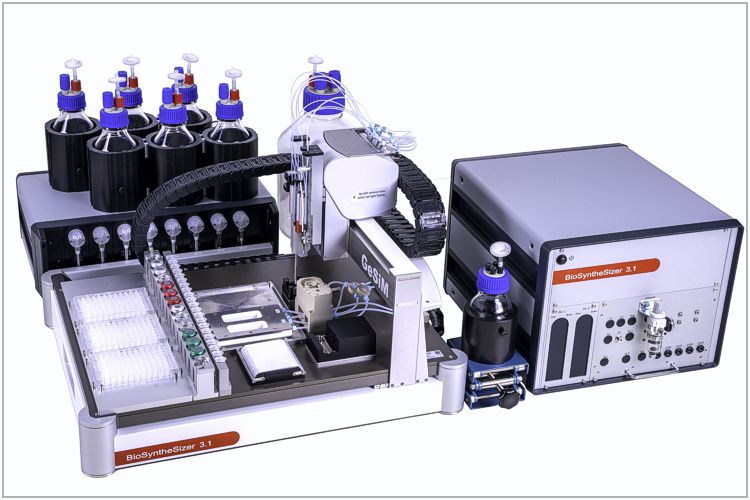Array-based Chemical Synthesis:
DNA- and protein microarrays are available for many years, nowadays widely used for modern in-vitro diagnostics. They are based on prefabricated biomolecules, tethered on solid surfaces by special surface chemistry (E.g. Amino-silane slides). When the spotted arrays are exposed to the analyte, just one specific reaction can happen on each spot with high spatial resolution. Single spots can be as small as 100 Microns. The GeSiM Nano-Plotter is a proven tool for preparing these kinds of arrays.
Customers at Technical University of Dresden now develop more sophisticated methods to run complex chemical synthesis in the array format, e.g., peptide synthesis. Peptide arrays synthesized on cellulose membranes are already commercially available. However, high consumption of proteins, as well as light scattering during detection, limit this technology. Glass surfaces are superior, however, fixation of reactants based on aprotic organic solvents (e.g. DMF and DMSO) on the glass surface is challenging (spread of solvents over a large area or vapor mediated undesired motion of droplets).
The researchers in Dresden run a GeSiM BioSyntheSizer. The instrument is capable of microarraying featuring piezoelectric tips with drop volumes below half a Nanolitre. Further, needle pipetting incl. vial penetration and aspiration from 96well plates allow more complex chemical reactions. The instrument adopts a user-made flow-cell, accommodating two glass slides. Rinsing and drying of the slide surfaces – synchronized with the array spotting algorithm – allow “switchable” surfaces, optimized for subsequent chemical reactions and later bioscreening. Besides peptide chemistry, multicomponent chemical reactions also can be performed on the surface.

GeSiM BioSyntheSizer with wash tray for slides (middle), well plates for amino acids (left) and syringe unit with reservoir bottles (top). A so called “F-box” (right) comprises control computer, pressure regulation and more.
A recent publication reveals more details: Controlling Surface Wettability for Automated In Situ Array Synthesis and Direct Bioscreening, Weilin Lin et.al., ADVANCED BIOMATERIALS, Published 26th July 2021
Courtesy of:
Weilin Lin, Yixhin Zhang, Center for Molecular Bioengineering (B-Cube) at Technical University of Dresden

